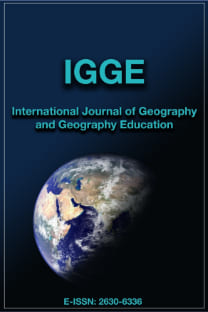CULTURAL DIFFUSION THEORY AND TOURISM IMPLICATIONS
Cultural Diffusion Theory, Culture, Tourism, Globalization
CULTURAL DIFFUSION THEORY AND TOURISM IMPLICATIONS
Cultural Diffusion Theory, Culture, Tourism, Globalization,
___
- Caton K. & Santos C. A. (2009). Images of the other: Selling study abroad in a postcolonial world. Journal of Travel Research, 48(2), 191- 204.
- Chang, T. C. (2000). Renaissance revisited: Singapore as a global city for the arts. International Journal of Urban and Regional Research, 24(4), 818-831.
- Chick, G. (2000). Editorial: Opportunities for cross-cultural comparative research on leisure. Leisure Sciences, 22(2), 79-91.
- Coss, P. R. (1985). Aspects of cultural diffusion in medieval England: The early romances, local society and Robin Hood. Past and Present, 108(1), 35-79.
- Dyer, P., Aberdeen, L. & Schuler, S. (2003). Tourism impacts on an Australian indigenous community: A Djabugay case study. Tourism Management, 24(1), 83-95.
- Echtner, C. M. & Prasad, P. (2003). The context of third world tourism marketing. Annals of Tourism Research, 30(3), 660-682.
- Faist, T. (2000). Transnationalization in international migration: implications for the study of citizenship and culture. Ethnic and Racial Studies, 23(2), 189-222.
- Ferrante, J. (2012). Sociology: A Global Perspective. (9th ed.). Stanford, CT: Nelson Education.
- Golden, P.B. (2006). Some thoughts on the origins of the Turks and shaping of Turkic Peoples. In Mair, V.H (Ed.), Contact and exchange in the ancient World (pp. 30-59). Honolulu, HI: University of Hawaii Press.
- Grünewald, R. A. (2002). Tourism and cultural revival. Annals of Tourism Research, 29(4), 1004-1021.
- Henrich, J. (2001). Cultural transmission and the diffusion of innovations: adoption dynamics indicate that biased cultural transmission is the predominate force in behavioral change. American Anthropological Association. 103(4), 992-1013.
- Jordan Bychkov T. G., Domosh M. & Neumann R. P. (2005). Human Mosaic. Basingstoke, England: Macmillan.
- Kariel, H. G. & Kariel, P. E. (1982). Socio-cultural impacts of tourism: an example from the Austrian Alps. Geografiska Annaler.Series B.Human Geography, 64(1), 1-16.
- Kaufman, J. & Patterson, O. (2005). Cross-national cultural diffusion: the global spread of cricket. American Sociological Review, 70(1), 82- 110.
- Kelley, D.B. (1997). Cultural diffusion. [Web Log Post]. Retrieved September 14, 2018, from http://mysite.verizon.net/dbkelley1/id2.html
- Kroeber, A. L. (1922). Elements of culture in native California. University of California Publications in American Archaeology and Ethnology,13, 259-328.
- Kroeber, A. L. (1940). Stimulus diffusion. American Anthropologist, 42(1), 1-20.
- Lewitt P. (1998). Social remittances: migration driven local-level forms of cultural diffusion. International Migration Review, 32(4), 926-948.
- Li, Y. (2003). Heritage tourism: The contradictions between conservation and change. Tourism and Hospitality Research, 4(3), 247-261.
- Morley, D. & Robins, K. (1995). Spaces of Identity: Global Media, Electronic Landscapes and Cultural Boundaries. London: Routledge
- Pemberton, H.E. (1936). The curve of culture diffusion rate. American Sociological Review,1(4), 547-556.
- Reisinger, Y. (2009). Cultural practices and tourism ımpacts on culture. In Y. Reisinger & Dimanche, F (Eds.), Advanced ınternational tourism: cultures and behavior (pp. 67-81). UK:Butterworth-Heineman.
- Riesman, D. & Denney, R. (1951). Football in America: a study in culture diffusion. American Quarterly, 3(4), 309-325.
- Robinson, M. (1999). Collaboration and cultural consent: Refocusing sustainable tourism. Journal of Sustainable Tourism, 7(3), 379-397.
- Sundqvist, S., Frank, L. & Puumalainen, K. (2005). The effects of country characteristics, cultural similarity and adoption timing on the diffusion of wireless communications. Journal of Business Research, 58(1), 107- 110.
- Wall, G. & Mathieson A. (2006). Tourism: Change, Impacts, and Opportunities. Harlow, England; New York, NY: Pearson Prentice Hall.
- Yayın Aralığı: Yılda 3 Sayı
- Başlangıç: 1996
- Yayıncı: Marmara Üniversitesi
KENTSEL GELİŞİM VE DÖNÜŞÜM SÜRECİNİN BELİRLENMESİ: DİYARBAKIR ÖRNEĞİ
EXAMINATION OF TEACHER CANDIDATES' PERCEPTION OF TOURISTS
FOÇA’DA İKİNCİ KONUTLARIN SOSYO-KÜLTÜREL VE EKONOMİK ETKİLERİ ÜZERİNE YEREL HALKIN ALGI VE TUTUMLARI
ORTAOKULDA ÖĞRENCİLERE VE ÖĞRETMENLERİNE GÖRE MEKÂNSAL DÜŞÜNME BECERİLERİ
Hasan GÖNÜLAÇAR, Mustafa ÖZTÜRK
CUMHURİYETİN İLK YILLARINDA AZINLIK VE YABANCI OKULLARINDA TARİH VE COĞRAFYA DERSİNİN YERİ
GÜVERDA BAĞLARININ COĞRAFİ ÖZELLİKLERİ VE KÜLTÜREL EKOLOJİSİ (ARTVİN)
COĞRAFYA VE SOSYAL BİLGİLER DERSLERİNDE CBS UYGULAMALARININ DEĞERLENDİRİLMESİ (SİNOP İLİ ÖRNEĞİ)
TRANS-BAYKAL (RUSYA) BÖLGESİ’NİN COĞRAFYASI
Mehmet ÇENESİZ, Mehmet Ali ÖZDEMİR
TÜRKİYE'DEKİ AFGAN GÖÇMENLERİN FIRSAT VE ZORLUKLARINA YÖNELİK BİR ANALİZ
